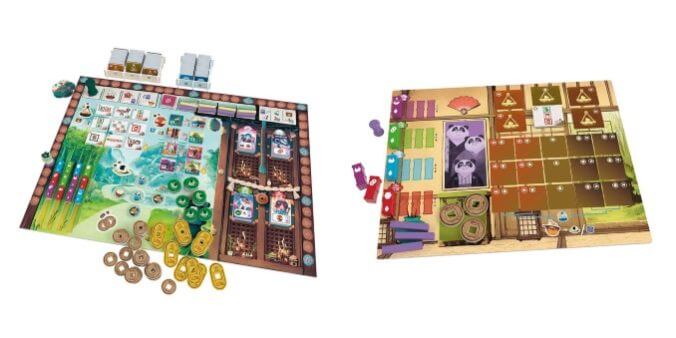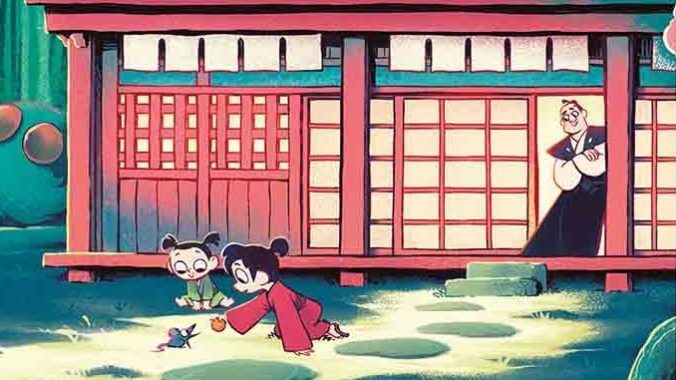One challenge that game designers have a hard time incorporating into their games is the idea of balance. Most competitive or solo games have a simple goal: rack up as many points as you can, whether to score more than your opponents or to beat an automa player or just to set a personal high score. What you do to achieve that higher point total doesn’t matter as long as you follow the rules. (I do not condone cheating, sorry.)
What you scarcely see in games, though, is the idea of balancing something else against the quest for points, whether it’s morality (which will always remind me of the 1985 videogame Ultima IV: Quest of the Avatar) or ethics or anything else beyond scoring. Some games, notably Reiner Knizia’s Tigris & Euphrates, introduce balance by discouraging players from running up the score; in that game, you score separately across four different colors, and your lowest score is the one that counts, so you need to pay attention to all of them as the game unfolds.
Bamboo tries to introduce balance in a slightly new way, taking some elements of feng shui for its theme and forcing players to balance their scoring quite literally. Players try to increase their happiness by taking bamboo shoots from their personal boards to take home improvement tiles, scoring tiles, or food tokens from the main board. Players get most of their points from placing tiles in their houses on their personal boards, but at the end of the game, if you have more victory points on either the left side or the right side, you take a decent penalty equal to double the points difference.
The game takes place over four rounds, each of which has four seasons, although nearly all of the game occurs in the summer as that’s when players take their actions. In spring, players receive one additional incense stick, which they’ll use to take actions in summer, and gain one ‘gift’ token that gives you a single bonus action. In summer, players take actions with those incense sticks, moving them to different colored spaces on their own boards with at least one bamboo piece on them. The bamboo pieces have different action symbols representing the four possible actions—take money, take food, buy a home improvement tile, take a scoring tile, or score a completed scoring tile—plus a wild action symbol.

The summer is the least intuitive part of the game, even though it’s where you’ll spend most of your time. You move your token to a different space on your board (out of four), and then take as many incense sticks as you have bamboo pieces on that space and place the incense on the matching colored temple on the main board. Then you take your bamboo pieces from that section and perform one of the two actions shown on those pieces, placing them on the grooved stalks on the main board to push up new bamboo pieces you’ll take for later turns. Managing your bamboo supply and choosing new ones becomes a huge part of the game, a combination of strategy and luck, and one of the few ways in which you can at least make life a little more difficult for your opponents. I don’t mind the incense-bamboo-action mechanism, but it required several turns to get the hang of it.
The scoring tiles go on your board above the spaces for your home tiles, and you will place home tiles to try to satisfy those scoring tiles’ requirements for points. The home tiles come in three different types—garden tiles, decoration tiles, and faith tiles. The scoring tiles might just require you to have one matching tile of that type, or anywhere from two to five tiles of specific types in a specific alignment, or to have tiles adding up to a minimum points total. The catch is that the scoring tiles apply only to one section of your house—the left, the right, or the center. The left and right sections must be in balance by the end of the game, or you’ll face the penalty I mentioned above.
In autumn, you see which players placed the most incense in each of the four temples, and those players earn Spirit tiles that grant them extra points or powers in future rounds. Then in winter players spend their food tokens to feed their families, requiring one food per home tile on their boards. After the fourth winter, players gain points from all of their completed scoring tiles, plus two points per spirit tile they’ve gained, and then deduct any points for a lack of “harmony” (balance) between the left and right sections of their houses.
For a game with some lovely art and a medium-sized box, Bamboo is surprisingly meaty. It’s a real Euro-style game with tile-laying and action selection mechanisms of heavier games, playing in more like 60 to 90 minutes depending on your player count. Its theme connects it to the same designer’s games Bitoku, a much heavier two to three hour game, and Silk, the lightest of the trio. Bamboo sits squarely in the middle in weight and complexity. There’s more randomness to the game than in typical Euros, especially in the home tiles, of which only eight are ever available for purchase at any time, so it’s quite possible the tile(s) you need won’t be around when you have the chance to buy them, and there isn’t a great way around that other than acquiring different scoring tiles so you’re not so dependent on any specific tile type. For weight and complexity, and even difficulty to learn, it’s quite similar to another game published by Devir, the tremendous Red Cathedral, but not quite as smooth to play. If you like games in that weight level—and appreciate getting a lot of game in a medium-sized box—then Bamboo would be a fit.
Keith Law is the author of The Inside Game and Smart Baseball and a senior baseball writer for The Athletic. You can find his personal blog the dish, covering games, literature, and more, at meadowparty.com/blog.

